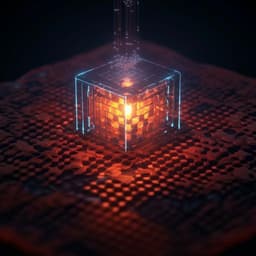
Physics
Accurate hyperfine tensors for solid state quantum applications: case of the NV center in diamond
I. Takács and V. Ivády
This groundbreaking research by István Takács and Viktor Ivády delves into the hyperfine parameters of the nitrogen-vacancy center in diamond, revealing significant inaccuracies in conventional computation methods. Their innovative real-space integration approach improves the accuracy to an astounding 1%, paving the way for precise quantum computing applications.
~3 min • Beginner • English
Introduction
Point defects in wide-bandgap semiconductors can host optically addressable spin qubits exhibiting millisecond coherence at room temperature. The magnetic environment in high-purity materials is dominated by the surrounding nuclear spin bath, where hyperfine coupling depends on the defect spin density and nuclear positions. While ESR and advanced ODMR techniques can measure hyperfine tensors of nuclei up to tens of angstroms from defects, the reliability of first-principles predictions for distant nuclear spins has been limited. Prior DFT studies report good accuracy for nearest neighbors, but recent supercell-size-scaling indicates sharply increasing relative errors for nuclei beyond about 5 Å, likely due to periodic boundary conditions and finite-size effects. This work investigates and remedies these inaccuracies for the NV center in diamond by introducing a real-space integration method that removes leading finite-size errors and by benchmarking results against high-precision experimental datasets.
Literature Review
- Point defect qubits (e.g., NV in diamond, Si vacancy and divacancy in SiC) exhibit long coherence and are promising for quantum technologies.
- Advanced measurements (ODMR, dynamic decoupling) detect nuclear spins at distances up to ~30 Å with hyperfine couplings down to ~1 kHz, enabling nanoscale magnetic resonance and using nearby nuclei as quantum resources.
- Hyperfine tensors can be computed via DFT and wavefunction-based methods; for close nuclei mean absolute relative errors around 4.7% have been reported, enabling defect identification by matching computed and measured hyperfine patterns.
- Finite-size errors in periodic supercell DFT, especially long-range dipole–dipole interactions and possible overlap of defect spin densities with periodic images, degrade accuracy for distant nuclei. Cluster models have been used to avoid periodic artifacts but are limited by model size.
- Recent scaling studies attribute large-distance hyperfine inaccuracies primarily to periodic boundary conditions and long-range dipole–dipole terms, motivating methods that emulate isolated defects while retaining accurate spin densities.
Methodology
- Physical model: Hyperfine Hamiltonian H_HF = S·A·I, with contributions from Fermi contact (A_fc) and dipole–dipole (A_dd). The hyperfine tensor elements depend on the spin density ρ(r) and nuclear positions R_J. Standard PAW-based periodic approaches (as in VASP) reconstruct core and valence spin densities and compute one-center (core) and valence contributions.
- Identification of finite-size issue: In periodic supercells, long-range dipole–dipole interactions cause nuclei to couple to a lattice of defect replicas, significantly perturbing A_dd, especially for weak couplings (<1 MHz). Increasing supercell size does not sufficiently mitigate these artifacts.
- Improved method: Real-space integration combined with PAW to emulate an isolated defect.
- Replace Fourier-space evaluation of the pseudo dipolar term by real-space integration of the full spin density on a fine grid.
- Introduce an external support lattice of nuclear sites extending to a 30 Å radius around the NV center, aligned with the supercell but excluding supercell atoms, to evaluate A_dd for nuclei outside the supercell.
- For nuclei within the supercell, integrate over the supercell volume excluding a PAW sphere around the nucleus; add one-center PAW contributions. For nuclei outside the supercell, set the local spin density at the nucleus to zero (neglect Fermi contact and one-center terms) and compute only the dipolar integral over the supercell spin density, removing interactions with periodic replicas.
- The total A_dd is the sum of the real-space integral and one-center contributions; the Fermi contact term (with core polarization) is taken from VASP’s PAW implementation for nuclei inside the supercell.
- Computational details:
- Systems: Diamond supercells with a single NV center; 512-atom and 1728-atom cells using experimental lattice parameter 3.567 Å.
- DFT settings: PBE and HSE06 hybrid functionals, with HSE(α) mixing parameters (α=0.25 default, also tested α=0.20); plane-wave cutoff 500 eV; Γ-point sampling; high accuracy (PREC=Accurate); SCF threshold 1×10^−5 eV; geometry optimized to max force <1×10^−2 eV/Å.
- Spin density grid: 0.036 Å spacing (a0/600) from the converged 1728-atom HSE or PBE calculation.
- Post-processing: In-house real-space integration code processes VASP outputs to compute hyperfine tensors for ~20,000 lattice sites within 30 Å of the NV center.
- Experimental comparison:
- Data set I: Hyperfine splittings from ref. 18; compared using A_split = sqrt(A_xx^2 + A_yy^2 + A_zz^2) or equivalent definition as described.
- Data sets II and III: A_zz (or A) tensor element from high-precision measurements refs. 19 and 23, respectively. A consistent sign convention difference between theory and experiments is noted and ignored for comparison.
- Nuclear spin positioning: For sets I and II, experimental hyperfine values are mapped to the closest theoretical site within error margins, potentially up to symmetry-equivalent positions. For set III, positions are taken from ref. 23.
Key Findings
- Standard periodic PAW/VASP hyperfine calculations show rapidly increasing absolute relative error (ARE) for small hyperfine couplings (<~1 MHz), often exceeding 100%, and larger supercells (512 vs 1728 atoms) do not systematically improve accuracy.
- The dominant finite-size error arises from the long-range dipole–dipole term evaluated under periodic boundary conditions, which makes distant nuclei interact with a lattice of defects instead of an isolated defect.
- The real-space integration method with a 30 Å support lattice removes leading periodic artifacts and dramatically improves agreement with experiments across all distances.
- Quantitative improvements:
- Overall reduction of mean absolute relative error by about 100-fold compared to standard VASP implementation.
- Data set I: MAPE = 3.8% (experimental average relative error margin ~1.2%).
- Data set II: MAPE = 1.5% (better than experimental relative error margin of ~3.3%, attributed to selection of closest matches within experimental error bars).
- Data set III (29 most accurate and positioned nuclei): MAPE = 1.79%; MSRE = −0.12%, indicating minimal systematic bias.
- Using HSE06 with α=0.20 slightly reduces MAPE to 1.69% but increases bias (MSRE −0.32%).
- PBE functional yields consistently larger errors than HSE06, especially for nuclei closer to the NV center.
- A point spin-density approximation yields MARE ~76% for set III, underscoring the need for accurate DFT spin densities.
- Residual errors correlate with the magnitude of the Fermi contact term and generally decrease with nuclear distance; neglect of Fermi contact for nuclei outside the supercell may contribute to some outliers.
- Extensive theoretical datasets released: hyperfine tensors for all lattice sites within 30 Å of the NV center (≈10^6 sites total coverage in published resources) and volumetric hyperfine data with <0.1 Å spatial resolution, enabling precise modeling and nuclear spin positioning.
Discussion
The study addresses the critical question of why hyperfine predictions for distant nuclei near the NV center are inaccurate under standard periodic DFT and how to correct them. The analysis identifies the long-range dipole–dipole term under periodic boundary conditions as the main source of error. By switching to real-space integration of the true spin density and augmenting with a support lattice of nuclear sites, the method emulates an isolated defect environment, removing interactions with periodic replicas. The resulting hyperfine tensors match experimental measurements with low percent-level errors across a broad distance range, making them suitable for high-precision simulations of NV-based quantum registers and for nuclear spin positioning from hyperfine fingerprints. Remaining discrepancies are largely linked to challenges in accurately evaluating the Fermi contact contribution, especially for nuclei near or outside supercell boundaries, and to the choice of exchange-correlation functional. Fine-tuning hybrid functional parameters can marginally improve accuracy but may introduce bias, suggesting that further advances will depend on improved core polarization treatments and possibly larger supercells or beyond-DFT approaches.
Conclusion
An improved real-space integration approach was developed to compute hyperfine tensors for the NV center in diamond, eliminating dominant finite-size artifacts inherent to periodic supercell calculations. The method delivers a roughly 100-fold reduction in mean absolute relative error compared to standard implementations and achieves mean percentage errors near 1–2% across distances up to 30 Å when using HSE06. Publicly released datasets and code enable accurate modeling of NV–nuclear spin systems and nuclear spin positioning from hyperfine data. Future work should target enhanced accuracy of core/Fermi contact terms, explore larger supercells and refined hybrid functional parameters, and leverage additional high-precision experimental data to further validate and improve theoretical predictions.
Limitations
- Residual errors correlate with the Fermi contact term; accurate evaluation of core polarization and on-site contributions is challenging.
- For nuclei outside the supercell, Fermi contact and one-center terms are neglected by construction, which may introduce errors for some sites.
- The mapping of experimental hyperfine values to theoretical lattice sites (for data sets I and II) can lead to overfitting within experimental error margins and uncertainty in exact nuclear positions (limited to symmetry-equivalent sites).
- Accuracy depends on the chosen exchange-correlation functional; PBE underperforms relative to HSE06, and functional tuning can trade off bias versus variance.
- Despite the support lattice and real-space integration, a finite 30 Å cutoff is used; extremely long-range contributions beyond this are neglected, though expected to be small.
- A consistent sign convention discrepancy with some experimental reports required ignoring sign for comparison.
Related Publications
Explore these studies to deepen your understanding of the subject.







